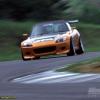por mi experiencia en carreras y llantas de magnesio cast, son muy frágiles se agrietan con cierta facilidad.
Me interesa, Edu. Pero, y las forjadas?
Bueno, ayer estuve leyendo más sobre el asunto:
http://www.tirerack....e.jsp?techid=90 All Wheels Are Round. Or Are They?
Though not enforced, there are quality standards to govern the production of wheels. Some countries though, like Germany and Japan, have government regulations requiring aftermarket wheels to meet certain criteria and ensure proper fit. The United States has taken steps to establish guidelines but it will be some time before they can enact regulation of any kind.
Consequently, all wheels are not made the same. The performance of an alloy wheel is a direct result of the manufacturing technique employed.
The Tire Rack offers a wide range of wheel choices from manufacture's that have adopted the manufacturing processes that meet the strict O.E.M. (Original Equipment manufacturers) requirements. Wheel companies that supply to the O.E.M. market must follow certain procedures during the manufacturing process to maintain the quality and integrity of their product.
There are many factors to consider when purchasing an alloy wheel.
What Is a Wheel and What Is a Rim? Are They the Same Thing?
It may seem obvious, but a wheel is comprised of a hub, spokes and rim. Sometimes these components will be one piece, sometimes two or three. The hub is the center portion of the wheel and is what attaches the wheel to the suspension. The spokes radiate out from the hub and attach to the rim. The rim is the outer part of the wheel that holds the tire. While many people refer to wheels as "rims," this is technically incorrect. We'll discuss several ways that wheels are manufactured below.
One-Piece Cast Wheels
This is the most common type of aluminum wheel. The casting of wheels is the process of getting molten aluminum inside a mold to form a wheel. There are different ways this can be accomplished and although it sounds simple, this is truly an art when done properly.
GRAVITY CASTING
Gravity casting is the most basic process of pouring molten aluminum into a mold utilizing the earth's gravity to fill the mold. Gravity casting offers a very reasonable production cost and is a good method for casting designs that are more visually oriented or when reducing weight is not a primary concern. Since the process relies on gravity to fill the mold, the aluminum is not as densely packed in the mold as some other casting processes. Often gravity cast wheels will have a higher weight to achieve the required strength.
LOW PRESSURE CASTING
Low pressure casting uses positive pressure to move the molten aluminum into the mold quicker and achieve a finished product that has improved mechanical properties (more dense) over a gravity cast wheel. Low-pressure casting has a slightly higher production cost over gravity casting. Low pressure is the most common process approved for aluminum wheels sold to the O.E.M. market. Low-pressure cast wheels offer a good value for the aftermarket as well. Some companies offer wheels that are produced under a higher pressure in special casting equipment to create a wheel that is lighter and stronger than a wheel produced in low pressure. Once again in the quest for lighter weight, there is a higher cost associated with the process.
Spun-Rim, Flow-Forming or Rim Rolling Technology
This specialized process begins with a low pressure type of casting and uses a special machine that spins the initial casting, heats the outer portion of the casting and then uses steel rollers pressed against the rim area to pull the rim to its final width and shape. The combination of the heat, pressure and spinning create a rim area with the strength similar to a forged wheel without the high cost of the forging. Some of the special wheels produced for the O.E.M. high performance or limited production vehicles utilize this type of technology resulting in a light and strong wheel at a reasonable cost. BBS has used this technology for several years in their production of racing wheels for Formula One and Indy cars. BBS's RC wheel for the aftermarket is an example of a wheel produced using spun rim technology.
In forged wheels, computer numerically controlled
(CNC) mills add the cosmetics and the bolt circle to exacting tolerances.
Forged
The ultimate in one-piece wheels. Forging is the process of forcing a solid billet of aluminum between the forging dies under an extreme amount of pressure. This creates a finished product that is very dense, very strong and therefore can be very light. The costs of tooling, development, equipment, etc., make this type of wheel very exclusive and usually demand a high price in the aftermarket.
Multi-Piece Wheels
This type of wheel utilizes two or three components assembled together to produce a finished wheel. Multi-piece wheels can use many different methods of manufacturing. Centers can be cast in various methods or forged. The rim sections for 3-piece wheels are normally spun from disks of aluminum. Generally, spun rim sections offer the ability to custom-tailor wheels for special applications that would not be available otherwise. The rim sections are bolted to the center and normally a sealant is applied in or on the assembly area to seal the wheel. This type of 3-piece construction was originally developed for racing in the early 1970s and has been used on cars ever since. The 3-piece wheels are most popular in the 17" and larger diameters.
There are now many options for 2-piece wheels in the market. The 2-piece wheel design does not offer as wide a range of application that a 3-piece wheel allows, however they are more common in the market and the prices start well below the average 3-piece wheel. Some 2-piece wheels have the center bolted into a cast or cast/spun rim section and other manufacturers press centers into spun rim sections and weld the unit together. When BBS developed a new 2-piece wheel to replace the previous 3-piece street wheel, they used the special rim-rolling technology (originally developed for racing wheels) to give the rim section the weight and strength advantages similar to a forged rim. On the high-end of the 2-piece wheel market you can find wheels using forged rims and forged centers. Since these are only sold in small volume and due to the high development and production costs associated with the forging process, they tend to be on the high end of the price scale.
High Light Technology (HLT)
The High Light Technology (HLT) process used in the manufacturing of O.Z. Racing's Alleggerita HLT and Botticelli HLT wheels, for example, uses rollers to compress and elongate the material along the barrel of a low-pressure cast aluminum wheel to obtain the desired profile. This process, which is directly derived from O.Z.'s experience in F1, produces wheels that are extremely light and strong.
The flow forming process and the HLT technologies combine to create mechanical characteristics similar to those of a forged wheel. This permits a dramatic reduction in wheel weight while enhancing structural rigidity vs. a standard cast wheel.
http://en.wikipedia....iki/Alloy_wheel Magnesium alloy wheels
Magnesium alloy wheel on a Porsche Carrera GTMagnesium alloy wheels, or "mag wheels", are sometimes used on racing cars, in place of heavier steel or aluminum wheels, for better performance. Magnesium wheels can be produced through various methods.
Forging
Forging can be done by a one or multi-step process forging from various magnesium alloys, most commonly AZ80,ZK60, (MA14 in Russia). Wheel produced by this method are usually of higher toughness and ductility than aluminum wheels, although the costs are much higher.
High pressure die casting,(HPDC)
This process uses a die arranged in a large machine that has high closing force to clamp the die closed. The molten magnesium is poured into a filler tuve called a shot sleeve. A piston pushes the metal into the die with high speed and pressure, the magnesium solidifies and the die is opened and the wheel is released. Wheels produced by this method can offer reductions in prce and improvements in corrosion resistance but they are less ductile and of lower strength due to the nature of HPDC.
Low pressure casting (LPDC)
This process usually employs a steel die, it is arranged above the crucible filled with molten magnesium. Most commonly the crucible is sealed against the die and pressurized air/cover gas mix is used to force the molten metal up a straw like filler tuve into the die. When processed using best practice methods LPDC wheels can offer improvements in ductility over HPDC magnesium wheels and any cast aluminum wheels, they remain less ductile than forged magnesium.
Gravity casting (permanent mold and sand casting)
Gravity cast magnesium wheels have been in production since the early 1920's. This method offers wheels with good ductility, and relative properties above what can be made with aluminum casting. Tooling costs for gravity cast wheels are among the cheapest of any process. This has allowed small batch production, flexibility in design and short development time.
-Interesante artículo de Sep 24.06 (originalmente publicado en
http://www.magnesium...n.php?news=2491):
Aluminum and Magnesium Wheel Advantages for Automotive Performance in Luxury and Sport Applications: http://ezinearticles...tions&id=423585 -Propaganda de las bondades del forjado del magnesio:
Magnesium Forgings - Forged Wheels: http://www.smw.com/c...s/catalog/id/15 Forged Mag Wheels: http://www.smw.com/contents/catalog/id/16 Forged Mag Wheels
Forged mag wheels are extremely durable and rigid. The strength of a forged wheel made from magnesium alloy exceeds many times the strength of a cast Al disk. This is achieved by forming a special fiber structure of the alloy manufactured by the precision 3-D hot forging process in a press with a 20,000 ton capacity.
A forged wheel does not crack; it bends without cracking and can be easily repaired, if necessary. Common casting defects, such as cavities and cracks, are non-existent in forging. So our forged mag wheels are stronger and more durable. Also, all forged mag wheels produced by SMW Engineering undergo strict quality control to comply with the road safety requirements.
Forged mag wheels are very light-weight. They weigh 1.5 times less than aluminum wheels, and 2.2 times less than steel wheels. Our forged magnesium wheels are twice as light compared as cast Al wheels of the same dimensions.
Wheel weight comparison:
Mg Al
Forged wheels 7.3 kg 11 kg
Cast wheels 10 kg 15 kg
Wheel weight is known to be a key component in “un-sprung” mass of the car (tires, wheels, brake disks, etc.), which directly affects vehicle performance parameters and the lifetime of suspension components.
In addition, because a lighter wheel is much easier to spin and to stop due to a lower momentum of inertia, forged mag wheels yield shorter breaking distance and faster acceleration, improve maneuverability and overall safety and reduce fuel consumption.
Here’s a list of the main benefits of forged mag wheels:
- Improved vehicle performance;
- Faster acceleration;
- Shorter braking distance;
- Improved safety and maneuverability;
- Fuel economy (up to 5-7%);
- Extended life-time of suspension components.
Magnesium is also a good heat conductor, which means cooler brake disks and brake drums as well as a longer life of brake pads. High heat conductivity of magnesium provides the following:
- Reduction of brake drum and brake disk heat;
- Increased durability of brake shoes.
The dampening ability (the ability to absorb shocks and vibrations caused by the road imperfections) of magnesium alloys is 100 times higher than those made from aluminum and 23 times higher than steel. This promotes the following:
- Increased durability of suspension bracket;
- Smooth and easy motion of the car;
- Longer lifetime of suspension and brakes.
Due to the specific metal structure obtained in the forging process, the corrosive resistance of forged mag wheels is much better than that of cast mag wheels.
-En un Nissan GT-R:
http://www.gtrblog.c...magnesium-whee/ Las 3 primeras:
http://www.tws-forge...tws_exspur.html -Hilo en un foro de Miatas:
http://forum.miata.n...ad.php?t=201736 P.D: Menuda MIERDA de editor que nos acaban de poner!!!
Editado por Storm, 28 julio 2011 - 09:14:01.























